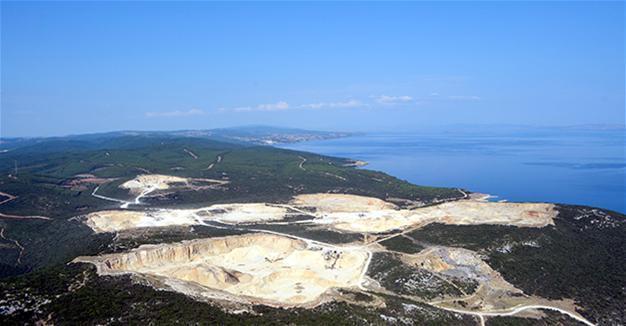Natural assets of Turkey's Saros Gulf face destruction
EDIRNE

The natural assets of the Saros Gulf, in the Keşan district of the northwestern province of Edirne, face destruction due to the opening of stone and limestone quarries, Doğan News Agency reported May 23.
“The trucks at the mines have been passing through our villages every day at every hour. We are inhaling dust. It sticks to our throat,” said one villager, Dilber Sarı.
The Gulf of Saros, as well as its coasts and surroundings, have a high potential for tourism with natural, cultural and historical assets. Accordingly, Turkish officials declared the unique environment as a Cultural and Tourism Protection and Development Zone with a regulation in 2006.
The Gulf of Saros also attracts many marine biologists and divers due to its large variety of fish, sea plants and sponges. The gulf was announced as Special Environmental Protection Area with a regulation in 2010.
The Environment and Urban Planning Ministry, however, declared in March report that “an environmental impact assessment report (ÇED) was not necessary” to conduct mining works in the region, prompting the Saros Gulf Mecidiye Tourism and Environment and Cultural Artifact Protection Association to appeal to an Edirne administrative court to demand a stay of execution.
The court agreed that such projects require an assessment report with an interim decision.
Although the case is continuing, some firms have reportedly made two new applications to the ministry to acquire a license to open two limestone quarries by the seaside in the region. The ministry has reportedly not provided either an affirmative or negative decision to the firms’ applications.
Bülent Kaçar, a lawyer for the environmental association, said there was already a regulation that forbid quarries from being constructed within 2 kilometers of water sources. “However, in this project the measurements of the engineers indicated an 850-meter distance. It is closer [than 2 kilometers] to the sea,” he said.
İbrice Harbor, which hosts several scuba schools that depend on the good conditions in the gulf, as well as forestry areas, have been negatively affected by the quarries, Doğan reported, adding that villagers had been staging protests to halt the environmental destruction.
Main opposition Republican People’s Party (CHP) lawmaker Erdin Bircan, who represents Edirne in parliament, also joined the protests, which were marked with banners saying, “Enough now, we no longer want quarries in our village,” “Don’t massacre nature, don’t destroy tourism.”
The CHP has already submitted approximately 10 parliamentary questions for an investigation of the environmental effects of the quarries in the region, he said.
“This is the sea coast of the Saros Gulf, it was declared a tourism region in 2006. Despite this, the Tourism Ministry is insensitive [to the situation]. The Environment and Urban Planning Ministry remains insensitive [to the situation],” Bircan said.
“If a person was asked where a limestone quarry should not be built in Turkey, they would probably suggest here,” the MP said. “There are ruins from Byzantium and Roman periods here. There is a diving center here. There are youngsters who come here from all over Turkey to go diving.”
Keşan Mayor Mehmet Özcan, also of the CHP, also waded into the debate. “These places are a first-degree protected area. Normally, you should not even bang a nail. The law says, for a quarry to be opened, there should be a 5 kilometer distance [at least].”
The villager, Sarı, expressed fears about the future. “In our village, there is a harbor for divers to dive. Are those who come here coming here to see our disgrace? My conscious is not at peace. Are we going to leave this to our grandchildren?” she said.
 The natural assets of the Saros Gulf, in the Keşan district of the northwestern province of Edirne, face destruction due to the opening of stone and limestone quarries, Doğan News Agency reported May 23.
The natural assets of the Saros Gulf, in the Keşan district of the northwestern province of Edirne, face destruction due to the opening of stone and limestone quarries, Doğan News Agency reported May 23.